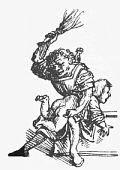Birching
Interesdom (Talk | contribs) |
(removed section on device) |
||
| Line 1: | Line 1: | ||
| − | '''Birching''' is [[physical punishment| corporal punishment]] with a [[birch]] | + | '''Birching''' is [[physical punishment| corporal punishment]] with a [[birch rod]], typically a [[spanking]] (i.e. given on the delinquent's [[buttock]]s, usually bared), although occasionally on the [[back]] and/or over the shoulders. |
[[Image:Angel birching a demon.jpg|thumb|420px|Angel birches a demon away on a stainglass (15th century, Narborough, Norfolk)]] | [[Image:Angel birching a demon.jpg|thumb|420px|Angel birches a demon away on a stainglass (15th century, Narborough, Norfolk)]] | ||
| − | |||
| − | |||
| − | |||
| − | |||
| − | |||
| − | |||
| − | |||
| − | |||
| − | |||
| − | |||
| − | |||
| − | |||
| − | |||
| − | |||
| − | |||
| − | |||
| − | |||
| − | |||
| − | |||
| − | |||
==Position== | ==Position== | ||
Revision as of 13:37, 30 December 2007
Birching is corporal punishment with a birch rod, typically a spanking (i.e. given on the delinquent's buttocks, usually bared), although occasionally on the back and/or over the shoulders.
Contents |
Position
The victim can go over the spanker’s lap or knee (usually only young boys, as with an adult the arm is not free for full impact, and bigger boys can be quite heavy; girls are less often spanked, since for an effective birching, the buttocks must be bare -- in the case of girls, this exposes their genitals) but will often be bent over an object (as in the expression ‘over a barrel’) to raise the buttocks, and even tied down if likely otherwise to leave this position under the agonizing pain.In some prisons a wooden apparatus known as birching donkey or birching pony, referring to the silhouette of an equine, was specially constructed for birchings. As there were no detailed rules, prisons and police stations over the empire devised, adapted and used myriad contraptions under even more numerous names that juvenile and adult offenders were bent over to have their bare buttocks professionally lashed; some models also allowed a standing or leaning position for other implements.
A simple alternative position known from school discipline is horsing (again an equine etymology), where the person to be spanked is hung by the arms from the neck and over the back of another person (e.g. a classmate), or on the shoulders of two or more colleagues.
History
It was the most common school, home and judicial punishment in Europe up to the 19th century when caning gained increasing popularity. A good, well-wielded birch is a very effective torment, more than presently often thought - in fact, there are accounts that even the legendary sting of the cat o' nine tails was less feared in certain prisons, although British judges usually prescribed the latter most for armed robbery, the birch for various lesser, 'unmanly' crimes such as indecent exposure- accordingly, the birch was generally applied to the bare buttocks (also on the continent), a humiliation usually befalling boys (like the boy's pussy, equally on the naked posterior), the 'adult' cat on the back or shoulders of adults.
In the United States, the Paddle (especially for boys) and whip-type implements including the prison strap were more prominent.
Today birching is rarely used for judicial punishment, and has also almost completely died out as a corporal punishment for children. In Britain birching as a judicial punishment for young offenders was abolished in 1947, but the Isle of Man (a small island between Britain and Ireland with its own legal system as a crown dependency outside the UK) caused a good deal of controversy by continuing to birch young offenders into the 1970s. In the Caribbean Commonwealth republic Trinidad and Tobago the 1953 Corporal Punishment Act (http://www.corteidh.or.cr/docs/casos/articulos/seriec_123_ing.pdf Interamerican Court of Human Rights March 11, 2005 judgment in Caesar v. Trinidad & Tobago - §49) allows the High Court to order males, in addition to another punishment (often concurrent with a prison term), to undergo corporal punishment in the form of either a 'flogging' with a knotted cat o' nine tails (made of cords, as in the Royal Navy tradition) or a 'whipping' with a 'rod' [i.e. switch] of tamarind, birch or other switches and allows the President to approve other instruments; in 2000, the original minimal age was raised from 16 to 18, the legal treshold of adulthood (e.g. cases in 1999 on CorPun); corporal punishment in schools was completely banned, but ther is reportedly wide support for a controlled reintroduction as recommndd in 2004 by a government-initiated study.
Non-punitive uses
- It remains as a nostalgic sadomasochistic practice, mainly in Northern and Eastern Europe.
- In Scandinavia, Finland and Russia there is also a tradition to strike one's body with soaked birch twigs in the Finnish sauna to increase blood circulation, opening the pores and as a form of massage. As these birch rods do not have their leaves removed, there is little pain involved.
